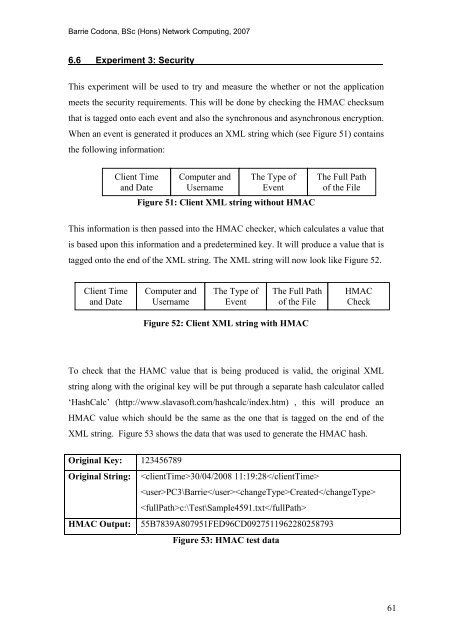Analysis and Evaluation of the Windows Event Log - Bill Buchanan
Analysis and Evaluation of the Windows Event Log - Bill Buchanan
Analysis and Evaluation of the Windows Event Log - Bill Buchanan
You also want an ePaper? Increase the reach of your titles
YUMPU automatically turns print PDFs into web optimized ePapers that Google loves.
Barrie Codona, BSc (Hons) Network Computing, 2007<br />
6.6 Experiment 3: Security<br />
This experiment will be used to try <strong>and</strong> measure <strong>the</strong> whe<strong>the</strong>r or not <strong>the</strong> application<br />
meets <strong>the</strong> security requirements. This will be done by checking <strong>the</strong> HMAC checksum<br />
that is tagged onto each event <strong>and</strong> also <strong>the</strong> synchronous <strong>and</strong> asynchronous encryption.<br />
When an event is generated it produces an XML string which (see Figure 51) contains<br />
<strong>the</strong> following information:<br />
Client Time<br />
<strong>and</strong> Date<br />
Computer <strong>and</strong><br />
Username<br />
The Type <strong>of</strong><br />
<strong>Event</strong><br />
Figure 51: Client XML string without HMAC<br />
The Full Path<br />
<strong>of</strong> <strong>the</strong> File<br />
This information is <strong>the</strong>n passed into <strong>the</strong> HMAC checker, which calculates a value that<br />
is based upon this information <strong>and</strong> a predetermined key. It will produce a value that is<br />
tagged onto <strong>the</strong> end <strong>of</strong> <strong>the</strong> XML string. The XML string will now look like Figure 52.<br />
Client Time<br />
<strong>and</strong> Date<br />
Computer <strong>and</strong><br />
Username<br />
The Type <strong>of</strong><br />
<strong>Event</strong><br />
The Full Path<br />
<strong>of</strong> <strong>the</strong> File<br />
HMAC<br />
Check<br />
Figure 52: Client XML string with HMAC<br />
To check that <strong>the</strong> HAMC value that is being produced is valid, <strong>the</strong> original XML<br />
string along with <strong>the</strong> original key will be put through a separate hash calculator called<br />
‘HashCalc’ (http://www.slavas<strong>of</strong>t.com/hashcalc/index.htm) , this will produce an<br />
HMAC value which should be <strong>the</strong> same as <strong>the</strong> one that is tagged on <strong>the</strong> end <strong>of</strong> <strong>the</strong><br />
XML string. Figure 53 shows <strong>the</strong> data that was used to generate <strong>the</strong> HMAC hash.<br />
Original Key: 123456789<br />
Original String: 30/04/2008 11:19:28<br />
PC3\BarrieCreated<br />
c:\Test\Sample4591.txt<br />
HMAC Output: 55B7839A807951FED96CD0927511962280258793<br />
Figure 53: HMAC test data<br />
61










![Unit 5. Switches and VLANs [PDF]](https://img.yumpu.com/34422504/1/184x260/unit-5-switches-and-vlans-pdf.jpg?quality=85)





